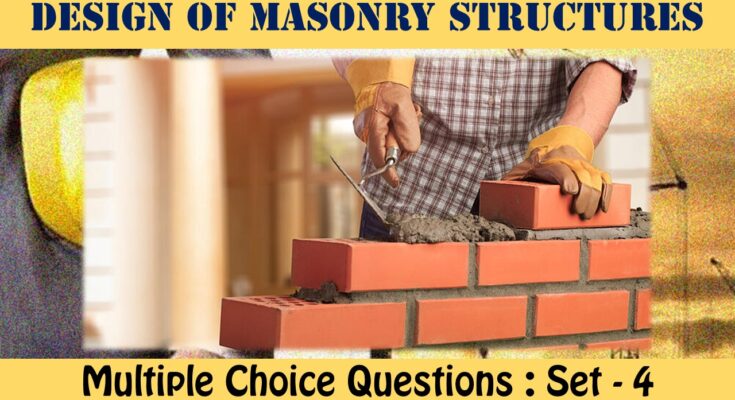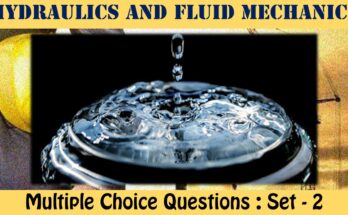MCQ Questions Civil Engineering Design of Masonry Structures
The interviewer is almost as nervous as the candidate in most interviews. You might wonder if you look confident enough, if you will hire the right person, or if you are asking the right engineering interview questions. The last question is arguably the most crucial part to worry about when you’re interviewing candidates. Other topics on Civil Engineering Multiple Choice Questions can be accessed
MCQ Questions Civil Engineering Design of Masonry Structures - Set - 4
Question 1:
For masonry built in 1:1:6 cement-lime-sand mix mortar or equivalent, the horizontal shear stress permissible on the area of a mortar bed joint is
a) 0.15 MPa
b) 0.125 MPa
c) 0.1 MPa
d) 0.075 MPa
Correct Answer – (A)
Question 2 :
Assertion A : For identical strength, a composite cement-lime mortar is preferred over cement mortar.
Reason R : Composite cement-lime mortar has higher drying shrinkage than cement mortar.
Select your answer based on the codes given below. Codes:
a) Both A and R are true and R is the correct explanation of A.
b) Both A and R are true but R is not a correct explanation of A.
c) A is true but R is false.
d) A is false but R is true.
Correct Answer – (C)
Question 3 :
A 200 mm thick brick masonry wall made of modular bricks carries an axial load of 30 kN/m from wall above and an eccentric load of 20 kN/m from RCC floor acting at a distance of 47.5 mm from the centre line of the wall. The resultant eccentricity ratio is
a) 0.090
b) 0.095
c) 0.100
d) 0.105
Correct Answer – (C)
Question 4 :
Direct load carrying capacity of a brick masonry wall standing freely as against when it supports RC slab will be
a) more
b) less
c) the same in both the cases
d) 100%
Correct Answer – (B)
Question 5 :
For strengthening a 50 m long and 5 m high straight compound wall built in brick work, which one of the following would be most suitable?
a) providing buttresses at certain intervals
b) providing a deeper foundation
c) using a richer mortar
d) using stronger bricks
Correct Answer – (A)
MCQ Questions Civil Engineering Design of Masonry Structures
Question 6:
Consider the following statements:
1. Masonry in rich cement mortar though having good strength with high shrinkage is much liable for surface cracks.
2. Lime mortar possesses poor workability and poor water retentivity and also suffers high shrinkage.
3. Masonry in lime mortar has better resistance against rain penetration and is less liable to crack when compared to masonry in cement mortar.
Which of these statements are correct?
a) 1,2 and 3
b) 1 and 2
c) 2 and 3
d) 1 and 3
Correct Answer – (D)
Question 7:
The basic stress in masonry units having height to width ratio of 1.5 may be increased by a factor of
a) 1.2
b) 1.4
c) 1.6
d) 2.0
Correct Answer – (C)
Question 8:
A 200 mm thick wall made of modular bricks is 5 m long between cross walls and 3.8 m clear height between RCC slabs at top and bottom. The slenderness ratio of the wall is
a) 15
b) 19
c) 20
d) 25
Correct Answer – (A)
Question 9:
Consider the following statements:
A high lime content in a composite cement-lime mortar results in
1. slow hardening.
2. quick setting.
3. weaker mortar. Of these statements
a) 2 and 3 are correct
b) 1 and 2 are correct
c) 1 and 3 are correct
d) 1, 2 and 3 are correct
Correct Answer – (C)
Question 10:
In the case of panel wall subjected to horizontal loads at right angles to the plane of the wall, with the mortar not leaner than Ml type, tensile stress in bending in the vertical direction may be allowed to the extent of
a) 0.4 kg/cm2
b) 0.7 kg/cm2
c) 1.0 kg/cm2
d) 1.2 kg/cm2
Correct Answer – (C)
- NCERT Solutions Class 12 Mathematics RD Sharma Sets : Exercise 1.1
- NCERT Solutions Class 12 Mathematics RD Sharma Sets : Exercise 1.2
- NCERT Solutions Class 12 Mathematics RD Sharma Sets : Exercise 1.3
- NCERT Solutions Class 12 Mathematics RD Sharma Sets : Exercise 1.4
- NCERT Solutions Class 12 Mathematics RD Sharma Trigonometric Functions : Exercise – 5.1
- NCERT Solutions Class 12 Mathematics RD Sharma Trigonometric Functions : Exercise – 5.2
- NCERT Solutions Class 12 Mathematics RD Sharma Trigonometric Functions : Exercise – 5.3
- NCERT Solutions Class 12 Mathematics RD Sharma Quadratic Equations : Exercise – 14.1
- NCERT Solutions Class 12 Mathematics RD Sharma Quadratic Equations : Exercise – 14.2
- NCERT Solutions Class 12 Mathematics RD Sharma Linear Inequations : Exercise – 15.1
- NCERT Solutions Class 12 Mathematics RD Sharma Linear Inequations : Exercise – 15.2
- NCERT Solutions Class 12 Mathematics RD Sharma Linear Inequations : Exercise – 15.3
- NCERT Solutions Class 12 Mathematics RD Sharma Linear Inequations : Exercise – 15.4
- NCERT Solutions Class 12 Mathematics RD Sharma Linear Inequations : Exercise – 15.5
- NCERT Solutions Class 12 Mathematics RD Sharma Linear Inequations : Exercise – 15.6
Multiple Choice Questions for Competitive Exams
- Multiple Choice Questions Class 12 Chemistry The Solid State
Set -1 Set -2 Set -3 Set -4 Set -5 - MCQ Questions Class 12 Solutions With Answers
Set -1 Set -2 Set -3 Set -4 Set -5 - MCQ Questions Class 12 Electrochemistry With Answers
Set -1 Set -2 Set -3 Set -4 Set -5 - MCQ Questions Class 12 Chemical Kinetics With Answers
Set -1 Set -2 Set -3 Set -4 Set -5 - MCQ Questions Class 12 Surface Chemistry With Answers
Set -1 Set -2 Set -3 Set -4 Set -5 - MCQ Questions Class 12 General Principles and Processes of Isolation of Elements With Answers
Set -1 Set -2 Set -3 Set -4 Set -5




